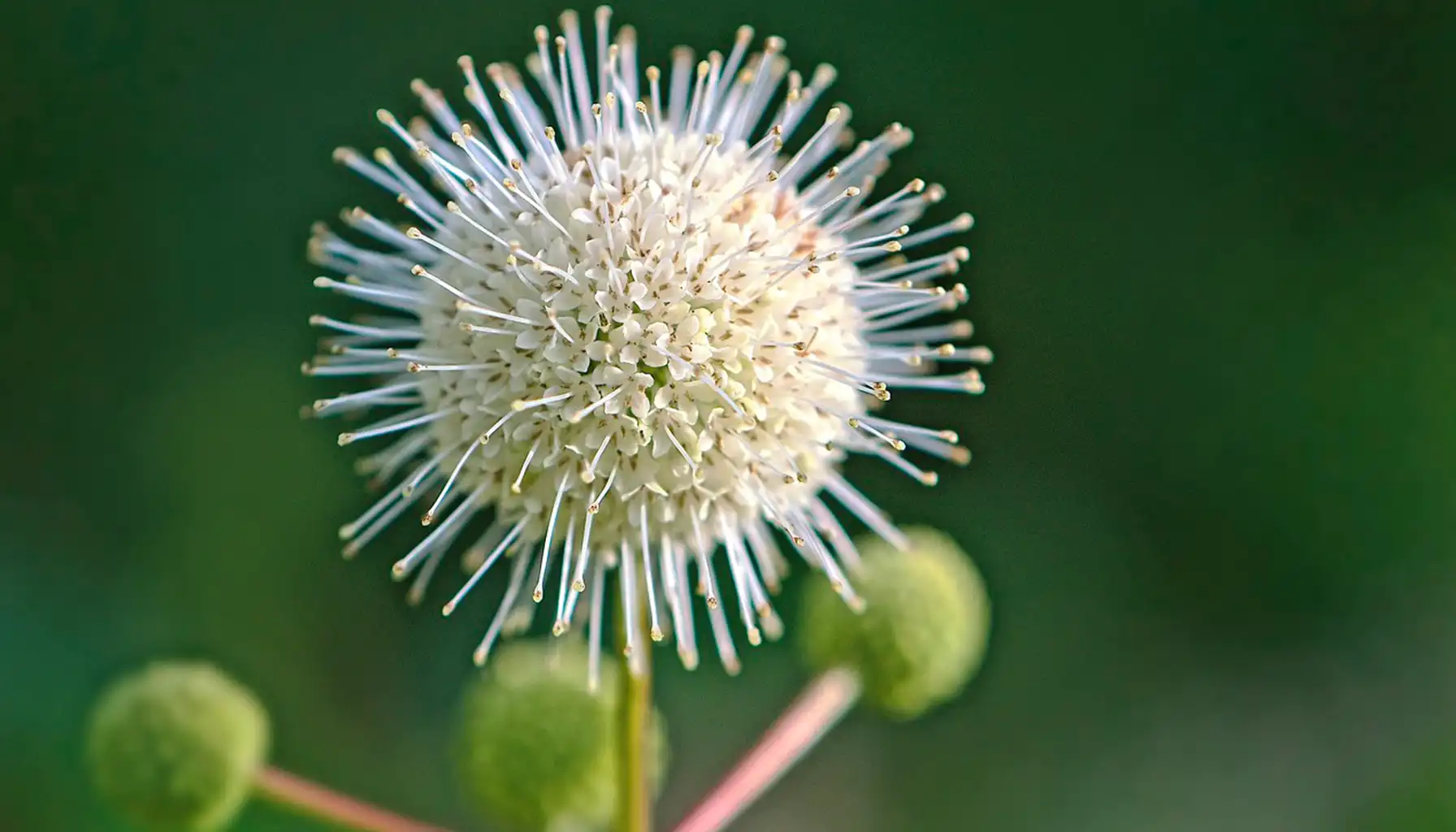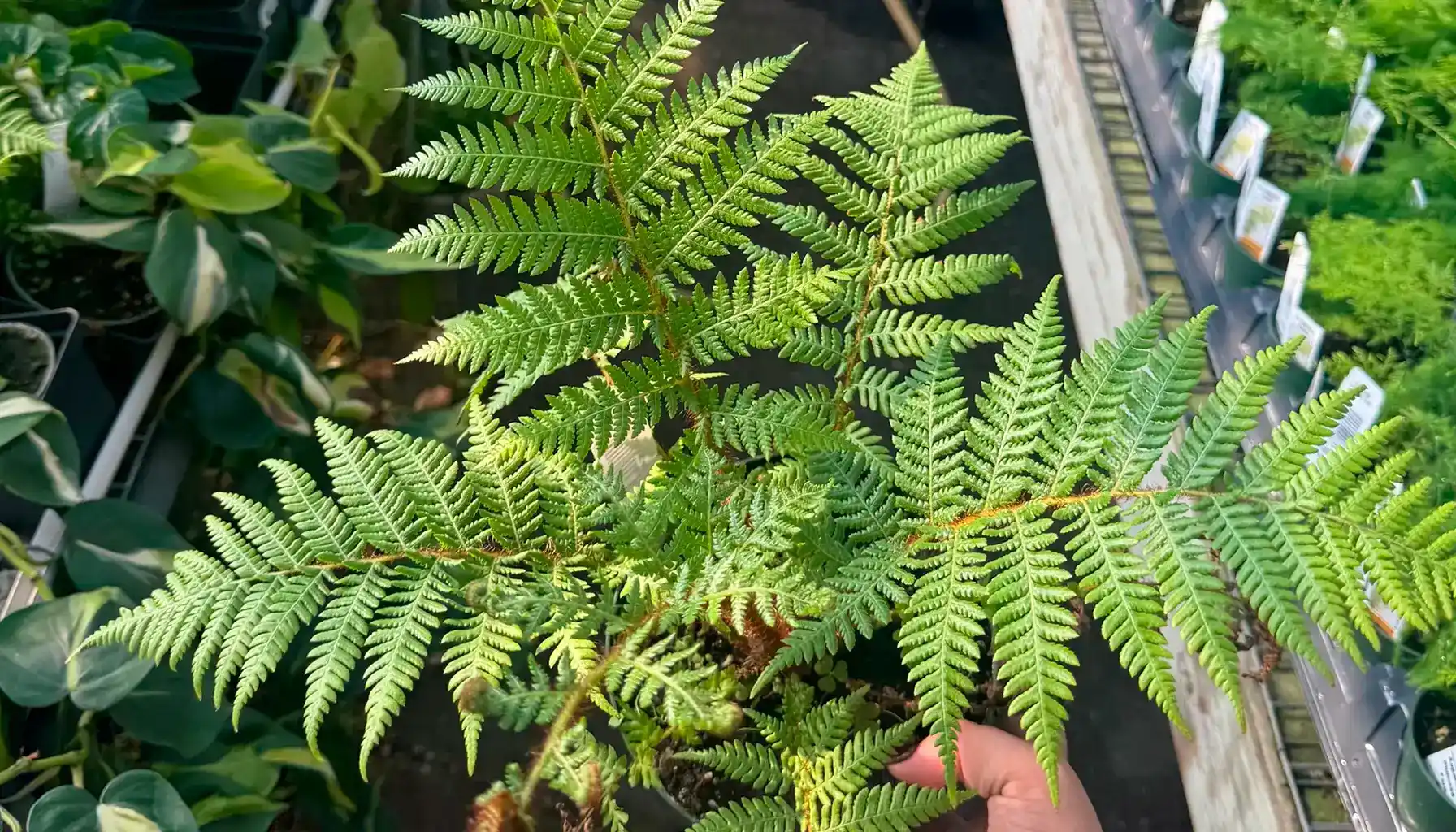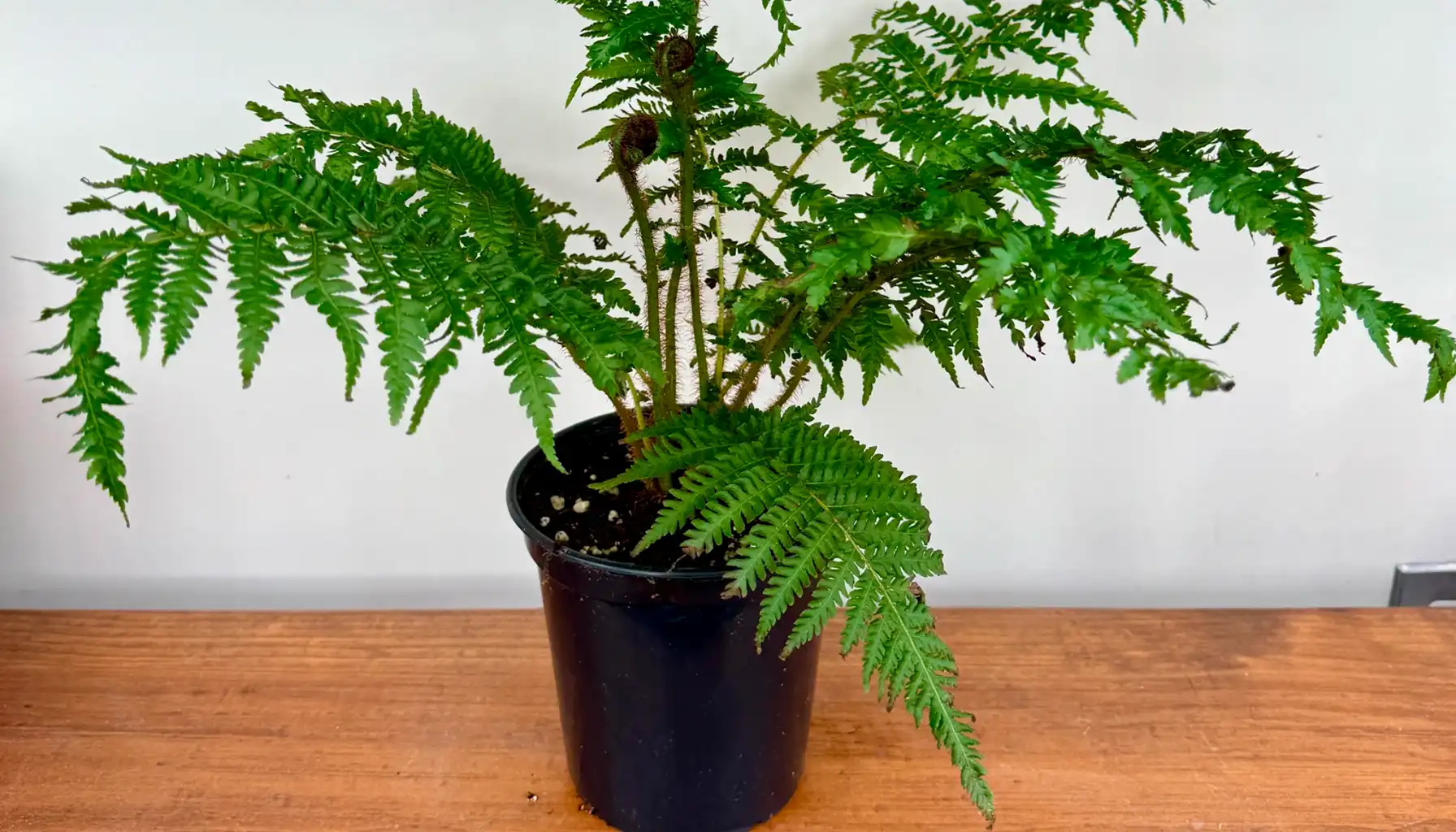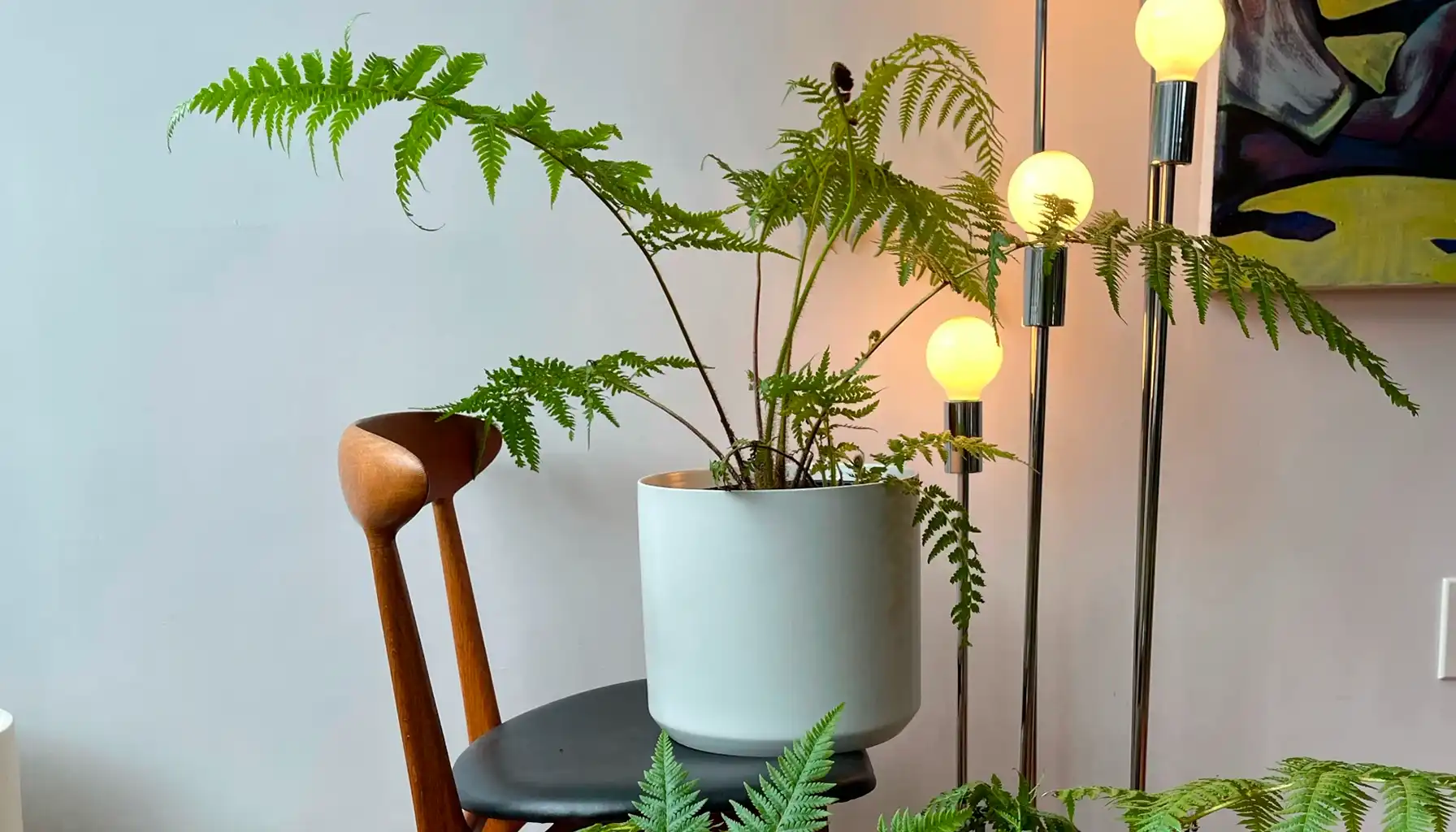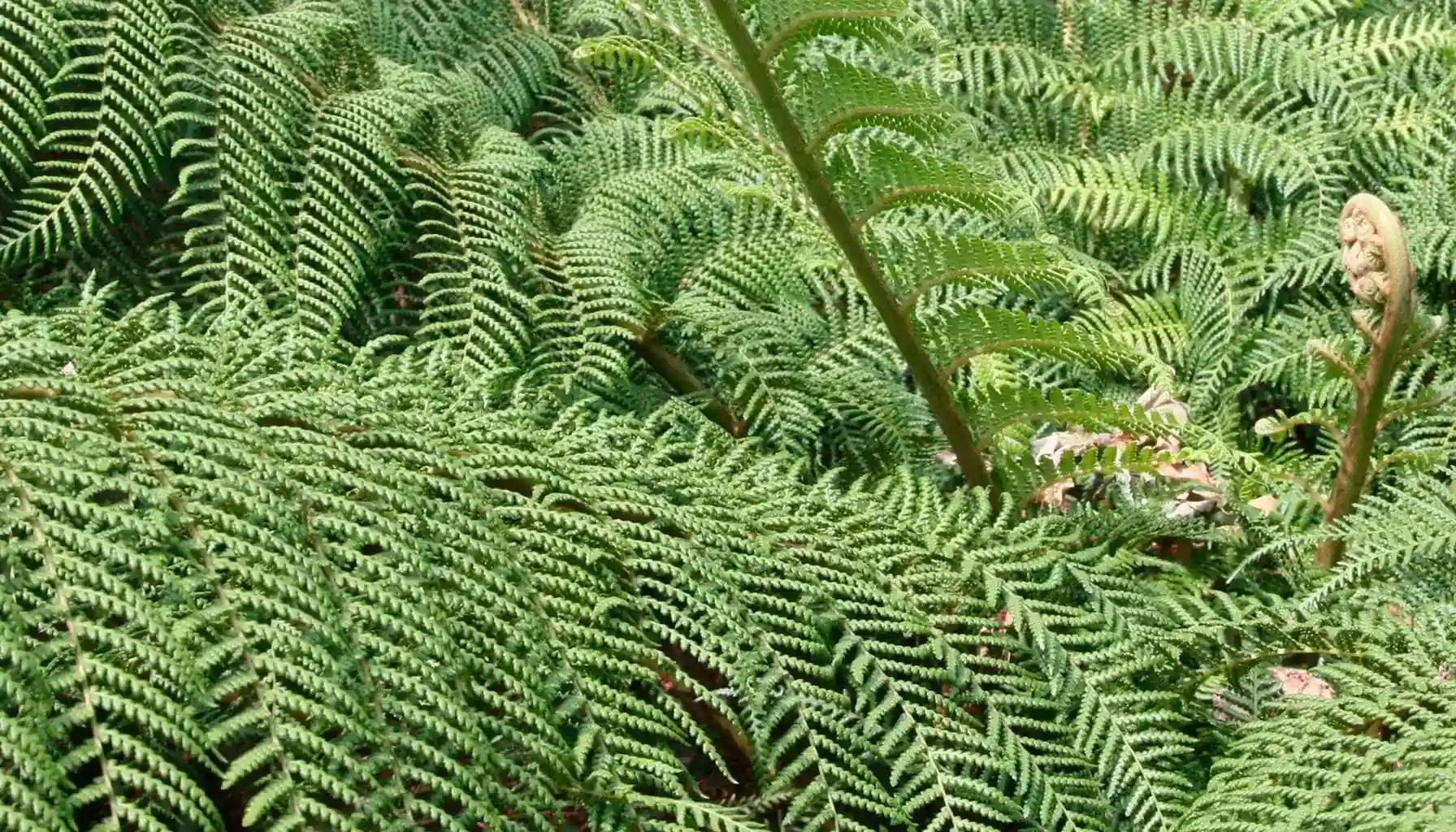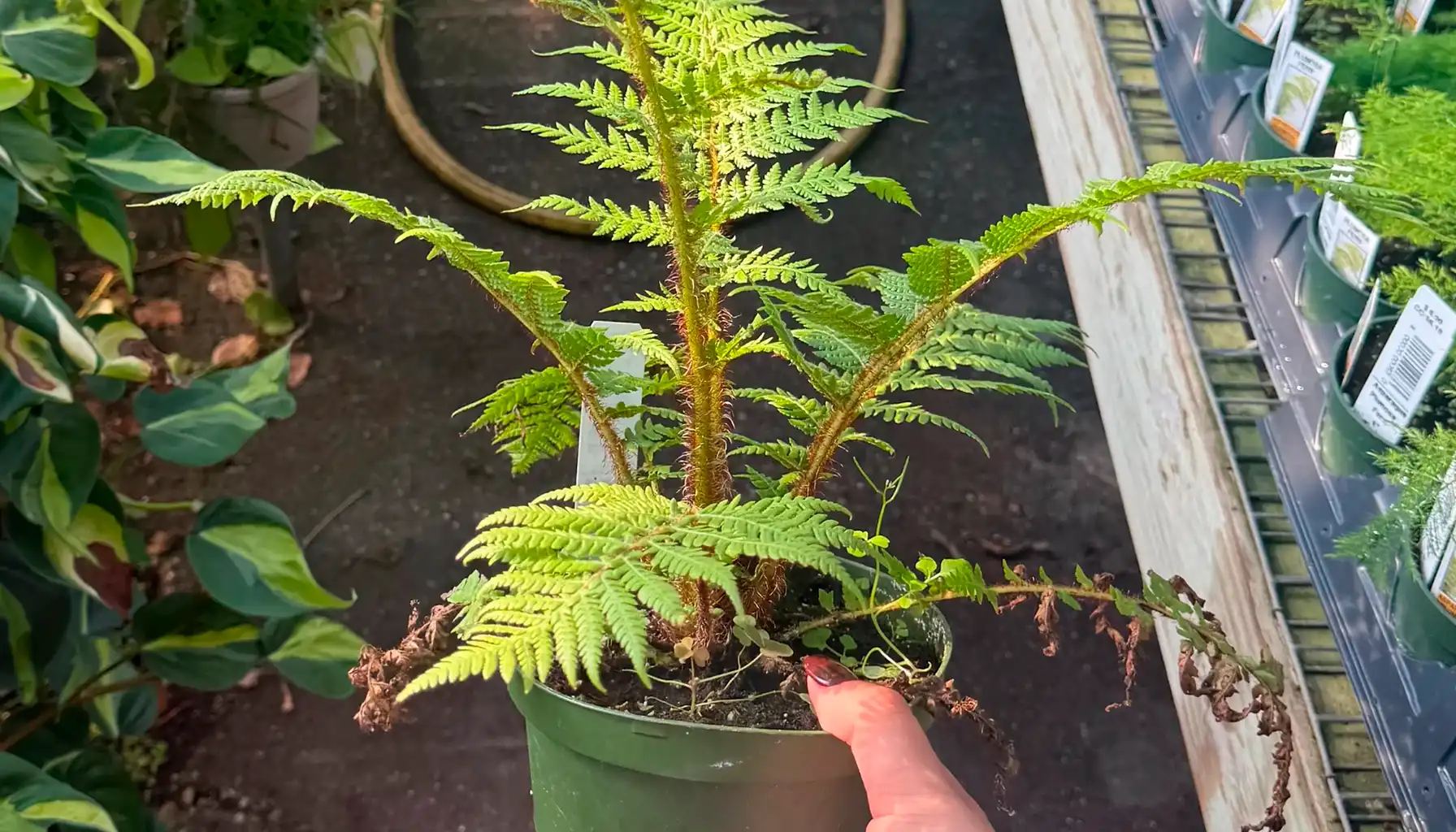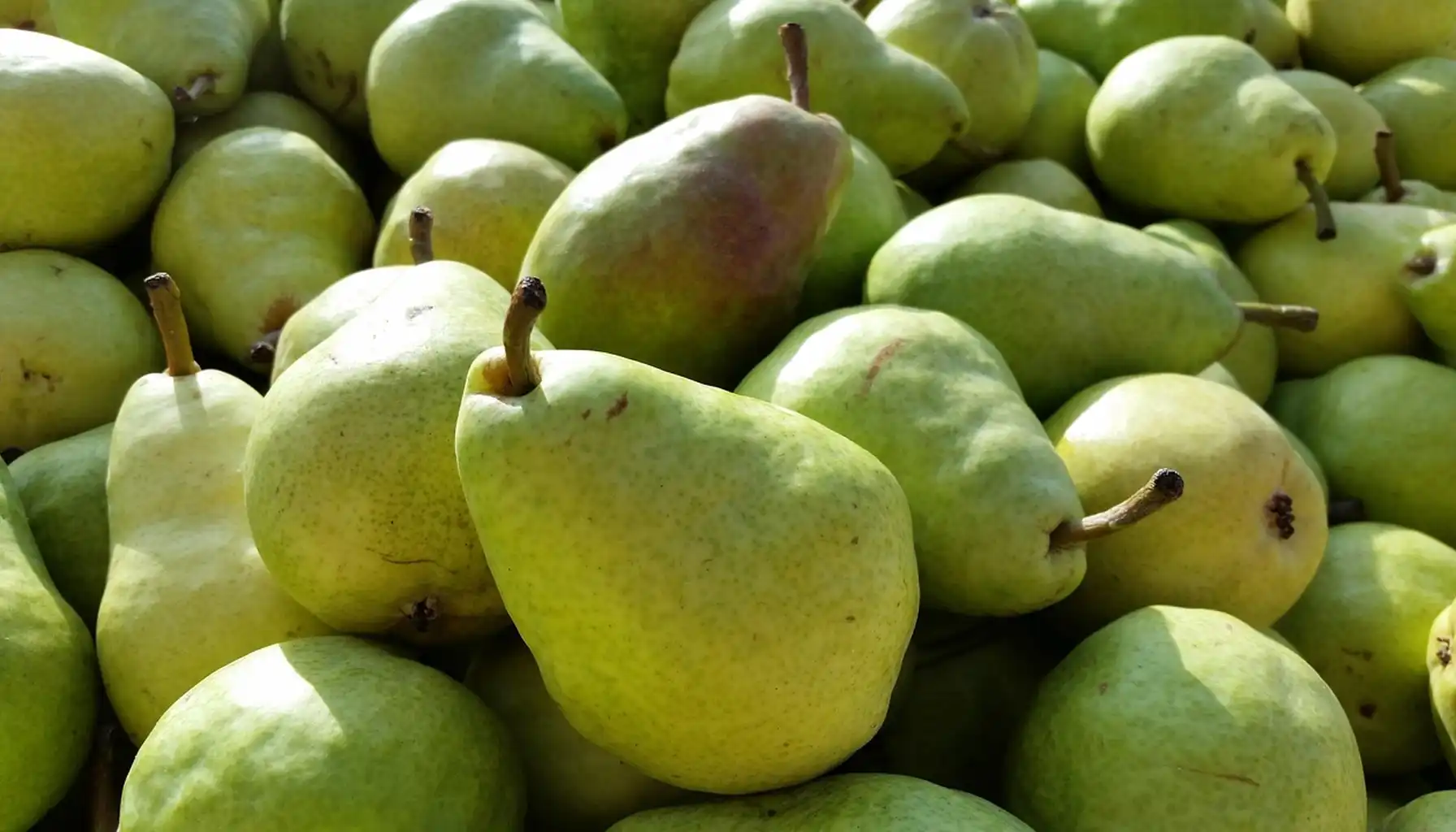The Australian tree fern (Cyathea cooperi, also seen as Sphaeropteris cooperi) has a single, slim trunk that lifts a wide crown of lacy fronds, creating cool shade and soft movement. In mild climates, it stays evergreen. In containers, it adapts well when given room, steady moisture, and humidity. Growth is quick in warm, sheltered sites.
What is the difference between Australian fern and…well, other ferns? There are so many ferns out there, you wouldn’t believe. Maybe you already have a fern in your garden, don’t you think? Check it with a free plant identifier. Point a camera and see the information on diseases, light, and water levels of this specific plant.
Botanical Overview
The Australian tree fern scientific name is Cyathea cooperi, also known by its synonym Sphaeropteris cooperi. It belongs to the Cyatheaceae family, a group of ancient ferns that form woody trunks and palm-like crowns. But it’s not a palm! Read more about palms to know the difference.
Native to the humid forests of eastern Australia, particularly New South Wales and Queensland, this species likes shaded gullies and along stream banks where the air stays moist and temperatures remain mild year-round.
Often referred to as the fern australian tree, this evergreen fern is valued for its finely divided, feathery fronds that can reach 2-4 meters (6-12 feet) long.
These fronds emerge in graceful spirals from the crown, forming an umbrella-like canopy over a fibrous, brown trunk covered with soft, hair-like scales. Over time, old fronds leave circular scars on the trunk.
The Australian tree fern botanical name is sometimes confused with related species such as Dicksonia antarctica, the Tasmanian tree fern, but Cyathea cooperi grows faster, develops a lighter trunk, and produces a more open crown. It is also widely grown as an ornamental in tropical and subtropical gardens around the world.
Growth Habit, Size & Rate
Its overall form resembles a palm, but its texture is softer and more delicate. In the ground under favorable conditions, the Australian tree fern size can reach 6-8 m (20-25 ft) tall with a canopy spreading 3-4 m (10-12 ft).
In the wild, some specimens may grow even taller. When grown in containers, it stays smaller due to limited root space and moisture.
The Australian tree fern height increases steadily each year because this species is among the fastest-growing tree ferns. With good moisture and humidity, the Australian fern growth rate averages 30-90 cm (1-3 ft) annually.
Young plants focus on trunk formation, then expand the crown as they mature. Fronds can extend 2-4 m (6-12 ft) long and create a layered, umbrella-like canopy that provides gentle shade below.
Growth slows in cool or dry climates and speeds up in warm, humid regions with filtered sunlight. Indoors, growth is more restrained but still noticeable when humidity and watering are consistent. Because it grows rapidly, plan for ample overhead space and allow room around the trunk for new fronds to unfurl freely.
Hardiness & Climate Needs
The Australian tree fern prefers frost-free conditions with consistent humidity. It grows best in Australian tree fern zone 9-11, thriving where winters are cool and summers are warm but not scorching. In coastal or subtropical climates, it remains evergreen year-round. It can survive brief cold spells but needs shelter from strong winds and frost.
The Australian tree fern hardiness range allows light freezes if the crown stays dry and the root zone is mulched. In colder regions, gardeners often grow it in large containers that can be moved indoors or into greenhouses for winter. Prolonged exposure to freezing temperatures can damage fronds and the growing tip.
As a frost-tender evergreen, the Australian tree fern cold hardiness limit is roughly -6°C (20°F). Temperatures below this may kill the crown, though plants sometimes recover if the trunk remains alive. Mulching and wrapping the trunk can improve survival in marginal areas.
The Australian tree fern temperature tolerance is best between 18–27°C (65–80°F). Extended heat above 32°C (90°F) can scorch fronds unless humidity is high and soil stays moist. In hot inland zones, place the plant in dappled shade and mist regularly to maintain humidity.
Protection Tips:
Plant in sheltered spots near walls or trees
Mulch the root zone to stabilize temperature
Avoid cold, drying winds
In containers, move under cover before frost
Zone | Temperature Range (°F) | Notes | Protection Needed |
9a–9b | 20–30°F | Marginal survival outdoors | Mulch heavily, cover in frost |
10 | 30–40°F | Reliable evergreen growth | Light mulch only |
11 | 40°F+ | Ideal climate year-round | None |
Light & Placement
The Australian tree fern light requirements are best described as partial sun to dappled shade. In its native forest habitat, it grows beneath tall tree canopies where sunlight filters gently through the leaves.
Outdoors, select a site that receives bright morning sun and afternoon shade, or filtered light throughout the day. Full, direct sun can scorch fronds, especially in hot, dry climates, while deep shade may cause thin, weak growth and reduced vigor.
Indoors, place the plant near an east- or north-facing window with bright but indirect light. Avoid positioning it directly under harsh midday rays from a south- or west-facing window unless diffused by sheer curtains. Rotate the container occasionally so all sides receive even light.
Consider overhead space and air movement. Fronds can reach several meters in length and need room to arch freely. Nearby trees, walls, or pergolas can provide the ideal partial shade. In windy locations, plant close to a building or tall hedge for extra shelter.
Soil & Watering
The Australian fern thrives in moist, humus-rich, well-drained soil. It naturally grows in rainforest floors and shaded slopes where organic matter collects and water stays consistent but never stagnant. To recreate these conditions, mix loam with compost, leaf mold, or peat to build a rich base. Avoid heavy clay that traps water or sandy soils that dry too quickly.
The Australian tree fern root system is fibrous and shallow, spreading near the soil surface. Because of this, it’s sensitive to drying out and waterlogging. Keep the top layer evenly moist at all times, but never soggy. Overwatering, especially into the crown, can cause rot. Instead, water the soil around the trunk, allowing moisture to soak through gradually.
Add a 5-8 cm (2-3 inch) mulch layer around the base to help maintain soil moisture and temperature. Use bark chips or shredded leaves, but keep mulch away from the crown to prevent rot. In dry or windy weather, increase watering frequency. In very humid conditions, check the soil before watering to avoid excess moisture.
Keep soil evenly moist
Avoid standing water and crown rot
Mulch to retain moisture
Use rainwater if possible
Check the soil daily in summer
Fertilizer & Feeding
Apply the Australian tree fern fertilizer every 4-6 weeks from spring through early autumn. Dilute to half strength to avoid leaf burn, as ferns absorb nutrients quickly through their fibrous roots. Pour the solution evenly around the root zone, never directly into the crown, to prevent rot. In cool or dormant months, stop feeding until active growth resumes.
Planting & Potting
The Australian fern is an ornamental plant that grows well both in the ground and in containers if given room, moisture, and shelter. Outdoors, plant it in spring when the soil is warm and easy to work. Choose a site with dappled shade and protection from strong winds.
Dig a hole twice as wide as the root ball and slightly deeper. Backfill with a mix of compost, loam, and coarse sand for drainage. Keep the crown at soil level; planting too deep can cause rot. Water thoroughly after planting to settle the soil.
As an Australian tree fern houseplant, it prefers a spacious pot with drainage holes and a rich, moisture-holding mix. Combine equal parts loam, peat, and perlite. Repot yearly in spring to refresh soil and allow space for new roots. Stop repotting once the plant reaches its indoor size limit.
For Australian tree fern indoor care, place the pot where it receives bright, filtered light and stable humidity. Mist often or use a pebble tray. Keep the soil evenly moist and feed lightly during active growth.
Propagation
The Australian tree fern propagation process relies on spores rather than seeds or cuttings. Like all ferns, this species reproduces by releasing fine spores from the undersides of mature fronds.
Propagation is best attempted in spring or summer when warmth and light are stable. Mature fronds develop brown spore patches called sori. Once they darken, cut a frond and let it dry in a paper envelope so the spores drop out. Use sterilized tools and clean containers, as spores are delicate and easily contaminated.
Spore Propagation:
Collect spores from fully mature fronds onto clean paper
Sterilize a soilless mix (peat and perlite) with boiling water; let it cool
Fill a small pot with the mix and level the surface
Sprinkle spores lightly on top-do not cover
Mist gently and cover the pot with a clear plastic dome or bag
Place in bright, indirect light at about 20°C (68°F)
Keep evenly moist; germination takes 2–6 weeks
Tiny green film-like growths (prothalli) appear first, followed by small fernlets. Once several true fronds develop, transplant seedlings carefully into separate pots.
Problems & Solutions
The Australian fern is resilient, but stress from incorrect watering, low humidity, or poor light can cause visible decline. These are the common Australian tree fern problems:
Browning or crispy frond tips usually signal dry air or underwatering. Boost humidity with misting or a humidifier, and ensure soil stays evenly moist
Yellowing fronds can indicate overwatering or poor drainage. Improve airflow and let the top layer dry slightly before the next watering
Soft crowns or foul smells often mean crown rot from water sitting in the center; always water around the base
Pests like spider mites and mealybugs may appear in dry conditions. Rinse fronds with water or apply neem oil
Blackened fronds after frost suggest cold damage; trim back affected growth and protect with mulch or covers next time
Issue | Likely Cause | Solution |
Brown or crispy tips | Low humidity, dry soil | Increase humidity, water consistently |
Yellowing fronds | Overwatering, poor drainage | Improve soil, reduce watering frequency |
Crown rot | Water is collecting in the crown | Water at base only, ensure drainage |
Pest infestation | Dry air, stress | Rinse fronds, apply neem oil or insecticidal soap |
Frost-damaged fronds | Cold exposure | Prune damaged fronds, mulch, and use frost cloth |
Slow growth, pale color | Low light or lack of nutrients | Move to a brighter spot, feed with diluted fertilizer |
Toxicity & Safety
The Australian fern is non-toxic to humans and pets, including cats and dogs. According to common plant safety references, there are no known poisonous compounds in its tissues. Accidental nibbling is unlikely to cause serious harm. However, the plant’s texture can still create minor irritation. But it’s always good to check the Guide to Toxic Plants You Should Know.
While not chemically harmful, Australian tree fern toxic to cats, and concerns mainly relate to its physical traits. The fronds and trunk are covered with fine hairs and scales that may cling to fur or skin. If a cat brushes against them frequently or chews the fronds, these fibers can cause mild mouth or skin irritation. It’s best to position the fern where pets cannot easily rub against it or dig in its soil.
When pruning or repotting, gardeners may also notice slight itching from the same fibers. Wearing gloves and long sleeves can prevent discomfort.
Species & Cultivars
The most widely grown species is the Cyathea cooperi Australian tree fern, also known as Cooper’s tree fern or scaly tree fern. This species is native to the rainforests of New South Wales and Queensland, where it grows in humid valleys and shaded slopes. It is recognized for its rapid growth, feathery fronds, and light brown trunk covered with soft scales.
Botanically listed as Cyathea cooperi (sometimes Sphaeropteris cooperi), the Australian tree fern Cyathea cooperi can reach 6-9 meters (20-30 feet) tall in ideal outdoor conditions. In cultivation, it’s chosen for its adaptability, fast trunk formation, and ability to recover quickly from minor cold damage.
Closely related ferns include Dicksonia antarctica (Tasmanian tree fern), which has a thicker trunk and slower growth but greater cold tolerance. Gardeners in cooler climates may select Dicksonia instead, while Cyathea cooperi suits warmer, frost-free regions or protected courtyards.
Conclusion
Though frost-tender, it can be protected outdoors in mild zones or grown in containers for easy winter shelter. Regular watering, light feeding, and removal of old fronds keep it lush and healthy year-round. Non-toxic to pets and adaptable to various settings, this fern suits shaded patios, courtyards, or conservatories.
FAQs
How fast does the Australian tree fern grow?
It is one of the fastest-growing tree ferns, adding 30-90 cm (1-3 ft) of trunk height each year under warm, humid conditions with consistent watering.
Can it live indoors year-round?
Yes. With bright, indirect light, high humidity, and regular watering, it grows well indoors as a large foliage specimen. Growth slows compared to outdoor conditions.
What is the lowest temperature it can handle?
This fern tolerates brief dips to about -6°C (20°F) but may lose fronds. Protect the crown with mulch or covers during cold snaps, and move container plants inside before frost.
Is the plant toxic to pets?
No. It is not known to be poisonous to cats or dogs, though fine hairs on fronds can cause mild irritation if touched or chewed.
Why are the fronds turning brown or dry?
Browning usually results from low humidity, underwatering, or direct hot sun. Increase moisture levels, provide shade, and trim damaged fronds.
Can it regrow after frost damage?
Yes. As long as the crown remains alive, new fronds will emerge in spring once temperatures warm.
How long does the Australian tree fern live?
In ideal conditions outdoors, it can live several decades, forming a tall trunk. Indoors, lifespan depends on consistent care and space availability.
Does it need pruning?
Remove old or yellow fronds close to the trunk to maintain appearance and allow new growth. Avoid cutting into the crown.
Related AI Plant Finder Posts
